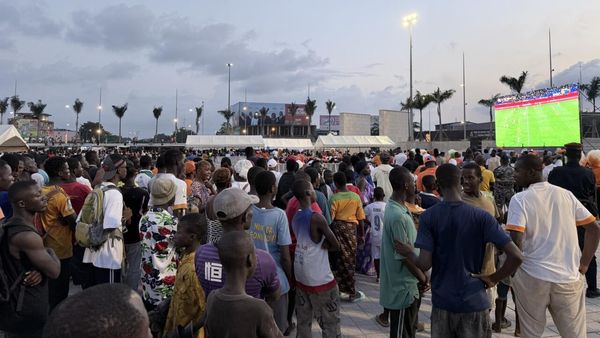
The first mayday call came late on Boxing Day.
Just before midnight, there had been an incident onboard the Flying Fish Arctos, a vessel competing in Australia’s most iconic boat race, the Sydney to Hobart yacht race.
The race, which sees yachts set out from Sydney Harbour to make the 630 nautical mile journey south to Tasmania, is a beloved fixture in Australia’s summer calendar.
Many go out to the Sydney Heads to watch the start of the race at midday on Boxing Day. Others, following along from home, will flick between coverage of the race and the Boxing Day Test match, as the country enjoys its laziest week of the year.
But on 27 December, the nation woke to news of tragedy.
Roy Quaden, one of the crew of the Flying Fish Arctos, competing in its 14th Sydney to Hobart, had been struck in the back of the head by the ship’s boom – a large metal pole that runs perpendicular to the mast and to which the mainsail is attached.
“[The boom] was moving violently through the night in challenging sea conditions and the crew member suffered a significant head injury,” Supt Joseph McNulty of the Marine Area Command said on Friday.
Quaden’s crewmates attempted CPR and alerted authorities. Water police were dispatched, but the man, a 55-year-old from Western Australia, died onboard.
The vessel then had to sail for several hours through the night, to Jervis Bay, where crew members were taken to a local navy base and questioned by police.
But the tragedy was not the only one of the night.
About 2.30am, another yacht, Bowline, suffered a near-identical incident, as a mainsheet hit a crew member – Nick Smith, from South Australia – in the head. Smith was an experienced crew member and was competing in his fifth Sydney to Hobart.
It was initially believed Smith, like Quaden, had been hit by the boom, but David Jacobs, vice-commodore of the Cruising Yacht Club of Australia, which administers the race, provided reporters with updated information on Friday afternoon.
“He was hit by the mainsheet and it threw him across the boat and unfortunately he hit his head on the winch and that’s what killed him.'’
McNulty earlier praised the crew for their efforts to keep Smith alive through CPR, but he died in the early hours of the morning.
He was remembered by sailing mates as a “lovely guy” who took delight in sharing his sailing knowledge with others, and a man who “loved adventures”.
Another Bowline crew member was injured in the incident, with a suspected broken shoulder, and had to be evacuated off the boat.
Both the Bowline and the Flying Fish Arctos have been seized by police who were onboard collecting evidence, and crew members were interviewed as part of an investigation.
Less than an hour after the episode on the Bowline, there was a third incident, a narrow miss that could have seen the night’s death toll rise to three.
At 3:30am, Luke Watkins, a 37-year-old crew member of the Porco Rosso, was swept overboard as the yacht sailed in strong winds past Green Cape on the New South Wales coast.
Watkins, who was rescued, told reporters he was pinned underwater and felt he was on his last breath, when “I somehow managed to unclip myself from the boat”.
“When I popped up above the water, the boat was probably 200m in front of me,” Watkins said.
Bobbing in rough seas, in the pitch dark, Watkins said he was able to keep sight of the boat’s stern light for about two or three waves.
“Then they were gone,” he said.
Watkins said after 10 minutes in the water, he began feeling cold and tried to “keep the thoughts under control”.
“It was pretty rough, getting thrown down waves – it’s hard to keep yourself above water a lot of the time.”
While he was trying to stay alive, his crew, as well as a jet dispatched by the Australian Maritime Safety Authority and a search and rescue vessel deployed by Eden Water Police, were searching for him.
After half an hour, he spotted a light – Porco Rosso returning.
“That’s when I got my head torch up and held it up so they could see where I was.”
“That is one of the most terrifying experiences that you can have,” said Jacobs. The fact it happened at night made it “ten-fold more scary”, he said.
The deaths are the first in the race since the disastrous 1998 Sydney to Hobart, in which six people died and 55 sailors had to be rescued. The race resulted in a NSW coronial inquest which led to mass reforms of the safety protocols that govern the race.
Before they set off on Thursday, skippers of three of the leading SuperMaxis said they were expecting wild weather.
“These conditions are probably the worst forecast I’ve ever had to go through,” the skipper of reigning line honours champion LawConnect, Christian Beck, said.
As of 4:30pm, 21 yachts – from the fleet of 104 – had retired from the race due to de-masting, sail damage, equipment failures and loss of life. The rest are pushing on through to Tasmania, across the notoriously difficult Bass Strait.
McNulty warned conditions could worsen overnight on Friday.
“It’s going to be a challenging night in the Bass Strait, big seas are coming,” he said.
– with Australian Associated Press
• This article was amended on 27 December 2024. A previous version incorrectly stated Luke Watkins’ name as Nick Watkins.







